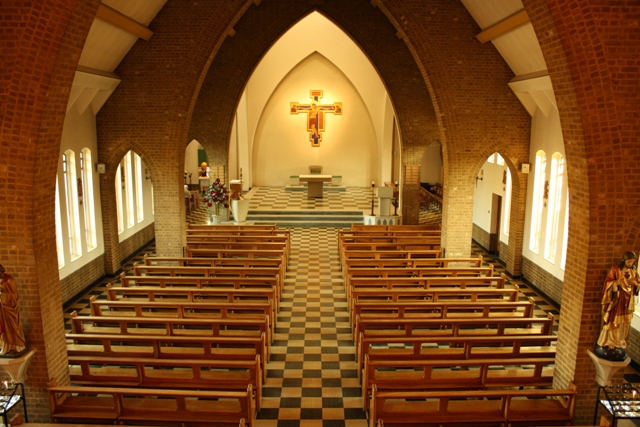The Nave of the Church.

"Whatever may be the design of a church, the area for the people is designated at the ‘nave’. The seats for the faithful should be so arranged that the people can participate easily in worship by being able to see that altar, lectern and chair, and that they should be able to come to Communion conveniently. There should be enough room for worshippers to stand and kneel conveniently. Therefore, whatever form the seats take, they should be spaced carefully and equipped with some form of comfortable kneeler." (Msgr. Peter J.Elliot – Ceremonies of the Modern Roman Rite. Page 17)
"Places should be arranged with appropriate care for thre faithful so that they are able to participate in the sacred celebrations visually and spiritually, in the proper manner. It is expedient for benches or seats usually to be provided for their use. The custom of reserving seats for private persons, however, must be reprobated. Moreover, benches or chairs should be arranged, easily in newly built churches, in such a way that the people can easily take up the postures required dor the different parts of te celebration and can easily come forward to receove Holy Communion.
Care should be taken that the faithful be able not only to see the priest, the deacon, and the lectors but also, with the aid of modern technical means, to hear them without difficulty."
General Instruction of the Roman Missal 311.
"Christ is always present in the Church, particularly in its liturgical celebrations. In the celebration of Mass, which is a memorial of the Sacrifice of the cross, Christ is really present forst of all in the assembly itself: "Where two or three come together in my name, there I am in their midst." (Matthew 18: 20). At Mass "the faithful form a holy people, a people whom God has mede his own, a royal priesthood, so that they mey give thanks to God and offer the spotless Victim not only through the hands of the priest but also together with him, and so that they mey learn to offer themselves." They should, moreover, endeavour to make this clear by their deep religious sense and their charity toward brothers and sisters who participate with them in the same celebration.
The liturgical assembly is never a random group of individuals but a gathering of God's people to exercise its royal priesthood inthe sacrifice of praise. Everything in the celebration is organised to encourage and foster an awareness of this assembly's common dignity and purpose, mutual interdependence, and connectedness with the wider Church.
The Church earnestly desires that all the faithful be led to that full, conscious, and active participation in litirgical celebrations called for by the very nature of the liturgy. Such participation by the Christian people as "a chosen race, a royal priesthood, a holy nation, God's own people" (1 Peter 2:9) is their right and duty by reason of their baptism.
